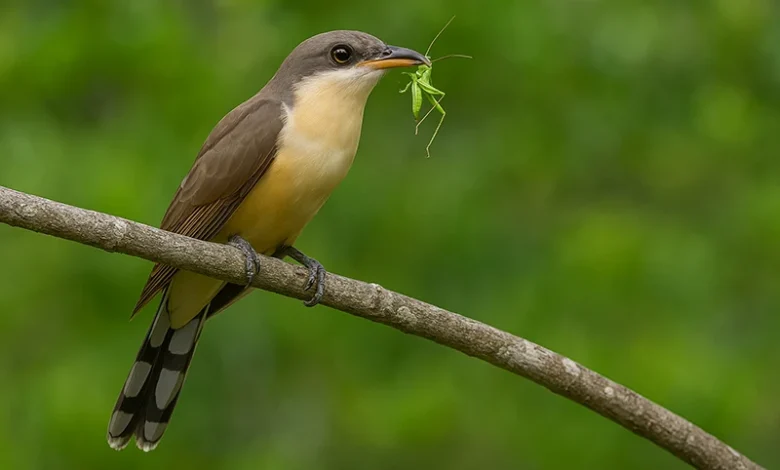Mangrove Cuckoo (Coucou-manioc)

The Mangrove Cuckoo (Coccyzus minor), locally known as “Coucou-manioc”, is a sleek and elusive bird found in Dominica’s coastal forests, mangroves, and lowland thickets. Known for its secretive behavior and soft, cooing call, this tropical cuckoo is more often heard than seen. While it ranges widely across the Caribbean and coastal Americas, in Dominica, it adds richness to the island’s birdlife—particularly in its lesser-traveled coastal ecosystems.
Appearance and Identification
The Mangrove Cuckoo is slender with a long, graduated tail and a slightly down-curved bill. Its upperparts are olive-brown, and its underparts are a pale buff to creamy white. A bold black mask runs across its eyes, making it easy to distinguish from similar species. It measures around 28–31 cm (11–12 inches) in length and has a slow, stealthy flight through dense foliage.
Habitat and Distribution in Dominica
This bird is typically found in mangrove swamps, coastal woodlands, and scrubby vegetation near the sea. Though relatively uncommon, patient birders can find it in key areas such as:
- Cabrits National Park – Especially near the mangrove edges and back trails.
- Indian River area (Portsmouth) – Coastal scrub and riverbank zones provide ideal cover.
- Soufrière Scotts Head Marine Reserve fringes – Dense bush and coastal vegetation support sightings.
- Layou River estuary – Occasionally seen or heard near lowland thickets along the river mouth.
Behavior and Birdwatching Tips
The Mangrove Cuckoo feeds mostly on insects, caterpillars, small lizards, and even fruits. It moves slowly and deliberately through branches, often staying hidden in dense cover. Its vocalization—a soft “cawp-cawp-cawp” or “whit-whit-whit”—is the best clue to its presence.
Tips for birdwatchers:
- Be silent and patient; this bird is wary and easily flushed.
- Focus on coastal trails, wetlands, and mangrove roots, especially early morning or late afternoon.
- Follow calls; experienced birders listen for its low, repeated notes deep in the canopy.
- Use binoculars and move slowly—Mangrove Cuckoos often freeze in place when spotted.
Nesting and Conservation
It nests in dense shrubbery or tangled branches, building a loose platform of twigs where the female lays 1–3 eggs. Though not endangered, mangrove habitat loss poses a potential risk to this species across its range. Dominica’s protected areas, such as in Cabrits and Soufrière, help safeguard local populations.
The Mangrove Cuckoo is a shy but rewarding species for dedicated birdwatchers in Dominica, representing the ecological richness of the island’s coastal habitats and lesser-known avian communities.




